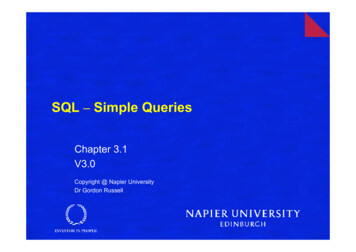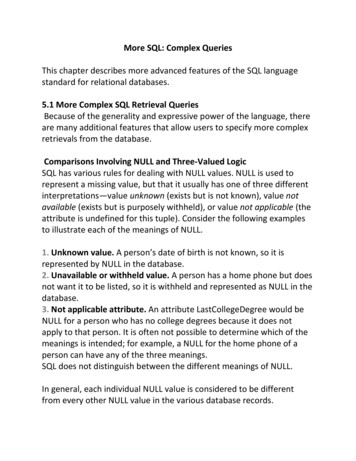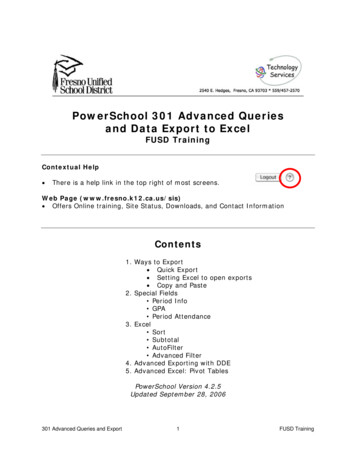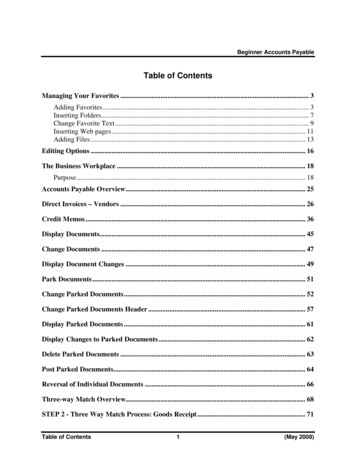
Transcription
SQL – Simple QueriesChapter 3.1V3.0Copyright @ Napier UniversityDr Gordon Russell
Introduction SQL is the Structured Query LanguageIt is used to interact with the DBMSSQL can– Create Schemas in the DBMS– Alter Schemas– Add data– Remove data– Change data– Access Data
DSL SQL is a Data Sub Language – DSLThis is a combination of two languages– DDL – Data Definition Language– DML – Data Manipulation Language The main way of accessing data is using the DML commandSELECT.The abilities of the SELECT command forms the majority ofthis material on SQL
Database ModelsA data model comprises a data structure a set of integrity constraints operations associated with the data structureExamples of data models include: hierarchic network relational
Relational DatabasesThe relational data model comprises: relational data structure relational integrity constraints relational algebra or equivalent (SQL)– SQL is an ISO language based on relationalalgebra– relational algebra is a mathematical formulation
Relational Data StructureA relational data structure is a collection of tables orrelations. A relation is a collection of rows or tuples A tuple is a collection of columns or attributes A domain is a pool of values from which the actualattribute values are taken.
Relational Structure contM E N U R elatio n o rT ab leD escrip tio nA ttrib u tesP riceT u p leD o m ain
Domain and Integrity Constraints Domain Constraints– limit the range of domain values of an attribute– specify uniqueness and ‘nullness’ of an attribute– specify a default value for an attribute when no value isprovided.Entity Integrity– every tuple is uniquely identified by a unique non-nullattribute, the primary key.Referential Integrity– rows in different tables are correctly related by valid keyvalues (‘foreign’ keys refer to primary keys).
Example Database In order to better understand SQL, all the example queriesmake use of a simple database.The database is formed from 2 tables, CAR and DRIVER.Each car may be owned by a DRIVER.A DRIVER may own multiple CARs.DRIVERCAR
DRIVERNAMEDOBJim Smith11 Jan 1980Bob Smith23 Mar 1981Bob Jones3 Dec 1986
CARREGNOMAKECOLOURPRICEOWNERF611 AAA FORDRED12000Jim SmithJ111 BBBBLUE11000Jim SmithA155 BDE MERCEDESK555 GHT FIATBLUE22000Bob SmithGREEN6000Bob JonesSC04 BFE SMARTBLUE13000SKODA
Each column holds data of a particular type– Integer, string, decimal, blobs– The range of values can be further constrainedIf a column in a row contains no data, it is NULL.It can indicate no possible value or unavailable data. All rows must differ from each other in some waySometimes a row is called a tupleCardinality is the number of rows of a tableArity is the number of columns of a table
Primary Keys In the design section the idea of a Primary Key is defined.A Primary Key is a group of 1 or more columns which, whentaken together, is unique in the tableNo part of a primary key can be NULL.In our example,– DRIVER: the primary key is NAME– CAR: the primary key is REGNOIn our example this means that no two drivers can have thesame name. In the real world this would be a problem, butthis is just an example.
Referential Integrity Note that there is a link between CAR and DRIVER viaOWNER.If there is a value in OWNER, then this value must alsoappear somewhere in DRIVER.If you change a driver’s name in DRIVER, you must makesure the same change is made in OWNER of CAR.The DBMS enforces the rules.If you try to break the rules the DBMS reports the problem asa REFERENTIAL INTEGRITY error.
SQL Basics Basic SQL statements include– CREATE – a data structure– SELECT – read one or more rows from a table– INSERT – one of more rows into a table– DELETE – one or more rows from a table– UPDATE – change the column values in a row– DROP – a data structure In this lecture the focus is on SELECT.
Simple SELECT SELECT column FROM tablenameSELECT column1,column2,column3 FROM tablenameSELECT * from tablenameSELECT * from CAR;REGNOMAKECOLOURPRICEOWNERF611 AAAFORDRED12000Jim SmithJ111 BBBSKODABLUE11000Jim SmithA155 BDEMERCEDESBLUE22000Bob SmithK555 GHTFIATGREEN6000Bob JonesSC04 BFESMARTBLUE13000
SELECT regno from CAR;REGNOF611 AAAJ111 BBBA155 BDEK555 GHTSC04 BFE
SELECT colour,owner from CAR;COLOURREDBLUEBLUEGREENBLUEOWNERJim SmithJim SmithBob SmithBob Jones
Formatting SPACES do not matterNEWLINES do not matterGood practice to put ; at the end of the query.CASE (except between single quotes) does not matter.These are all valid:SELECT REGNO FROM CAR;SElecT regnoFrom Car;
Comments To give you the ability to make notes in queries you areallowed to have comments.Comments are not executedA comment starts with -- and ends with a newlineThey are only permitted within a query.SELECT regno -- The registration numberFROM car -- The car storage table;
SELECT filters You can have rules in your queriesThese rules are tested for each row your query producesIf the rule is true, the row is displayedIf the rule is false, the row is not displayedThe rule starts with WHERESELECT columnsFROM tableWHERE rule
Simple Rule A simple rule might be to look for a car with a colour of RED.The rule would be colour 'RED'SELECT regno FROM CARREGNOF611 AAAJ111 BBBA155 BDEK555 GHTSC04 BFESELECT regno from CARWHERE colour 'RED'REGNOF611 AAA
Note Things between quotes is CASE SENSITIVE. ‘RED’ is not the same as ‘Red’ or ‘red’ Rules which mention fields – they can be used ifthey appear on the SELECT line or not.SELECT regno from CARWHERE colour 'RED'REGNOCOLOURF611 AAA RED
Comparisons Valid comparisons include ,! , , , , , – Colour ‘RED’ The colour must be red– Colour ! ‘RED’ The colour is not red– Colour ‘Red’ Same as ! – Price 10000More than 10000– Price 10000 More than or equal to 10000– Price 10000Cheaper than 10000– Price 10000 Cheaper or the same as 10000Numbers – You can say ‘10000’ or 10000. Strings alwayshave quotes
DATE Date comparisons can be trickyYou can use all the normal comparators with dates.SELECT name,dobfrom driverNAMEDOBJim Smith11 Jan 1980Bob Smith23 Mar 1981Bob Jones3 Dec 1986SELECT name,dob from driverwhere DOB ‘3 Jan 1986’NAMEDOBBob Jones3 Dec 1986
The tricky part with dates is remembering that dates getbigger as you move into the future.DATE1 DATE2 indicates DATE1 is in the future afterDATE2.SELECT name,dob from driverWHERE DOB ‘1 Jan 1981’NAMEDOBBob Smith23 Mar 1981Bob Jones3 Dec 1986
DATE Syntax It must be in quotesEach DBMS handles dates in a slightly different wayDates like ‘1 Jan 2003’ work quite well.Oracle permits dates like ‘1-Jan-2003’Oracle also permits dates like ‘1-Jan-03’– Be caseful if you type this it will assume 2003.– If you mean 1984 type 1984 not –04.You must always specify a day and a month. If you do notthe DBMS will report an error.
BETWEEN When dealing with dates sometimes you want to test to seeif a field value falls between two dates.The easiest way to do this is with BETWEENFind all drivers born between 1995 and 1999SELECT name,dob from driverWHERE DOB between ‘1 Jan 1985’ and ’31 Dec 1999’Between works for other things, not just dates SELECT regno from CARwhere price between 5000 and 10000;
NULL NULL indicates that something has no valueIt is not a value, and you cannot use normal comparisonoperators.For instance, looking for cars without owners Wrong:Wrong: SELECT regno from car where owner NULLSELECT regno from car where owner ‘NULL’Instead there are two special operators, IS NULL, andIS NOT NULL
SELECT regno from carWHERE OWNER is nullREGNOSC04 BFEREGNOSELECT regno from carWHERE OWNER is not nullF611 AAAJ111 BBBA155 BDEK555 GHTSC04 BFE
LIKE Sometimes you want to have a rule involvingpartial strings, substrings, or wildcards LIKE does this, and is a slot-in replacement for ‘ ‘ If the string contains ‘%’ or ‘ ’, LIKE uses them tosupport wildcards.– % - Matches 0 or more characters in the string– - Matches exactly 1 character in the string
Examples Name LIKE ‘Jim Smith’Name LIKE ‘ im Smith’Name LIKE ‘ Smith’Name LIKE ‘% Smith’Name LIKE ‘% S%’Name LIKE ‘Bob %’Name LIKE ‘%’e.g. Jim Smithe.g. Tim Smithe.g. Bob Smithe.g. Frank Smithe.g. Brian Smarte.g. Bob Martini.e. match anyone LIKE is more expensive than If you are not using wildcards, always use rather thanLIKE.
SQL Basics Basic SQL statements include – CREATE – a data structure – SELECT – read one or more rows from a table – INSERT – one of more rows into a table – DELETE – one or more rows from a table – UPDATE – change the column values in a row – DROP – a File Size: 604KBPage Count: 32











